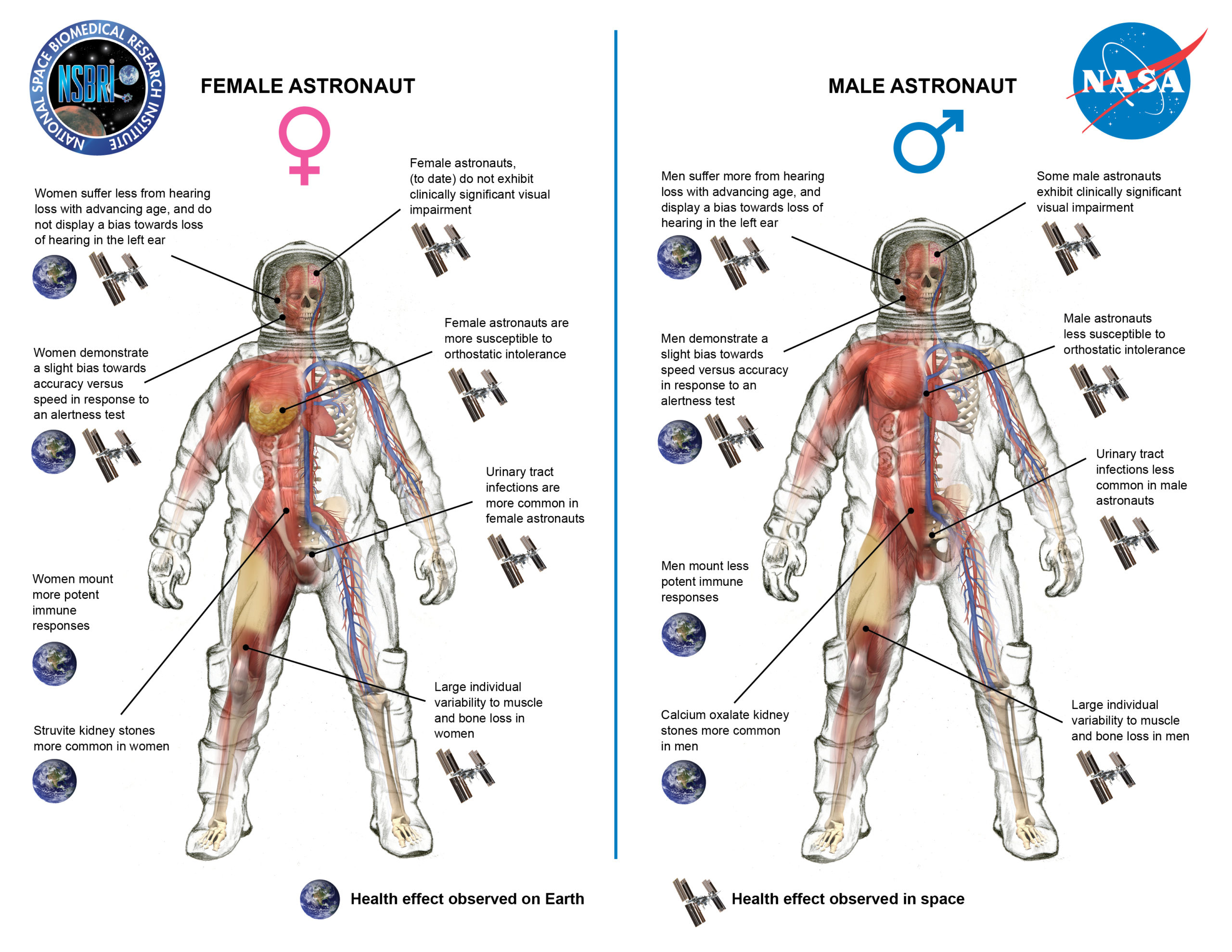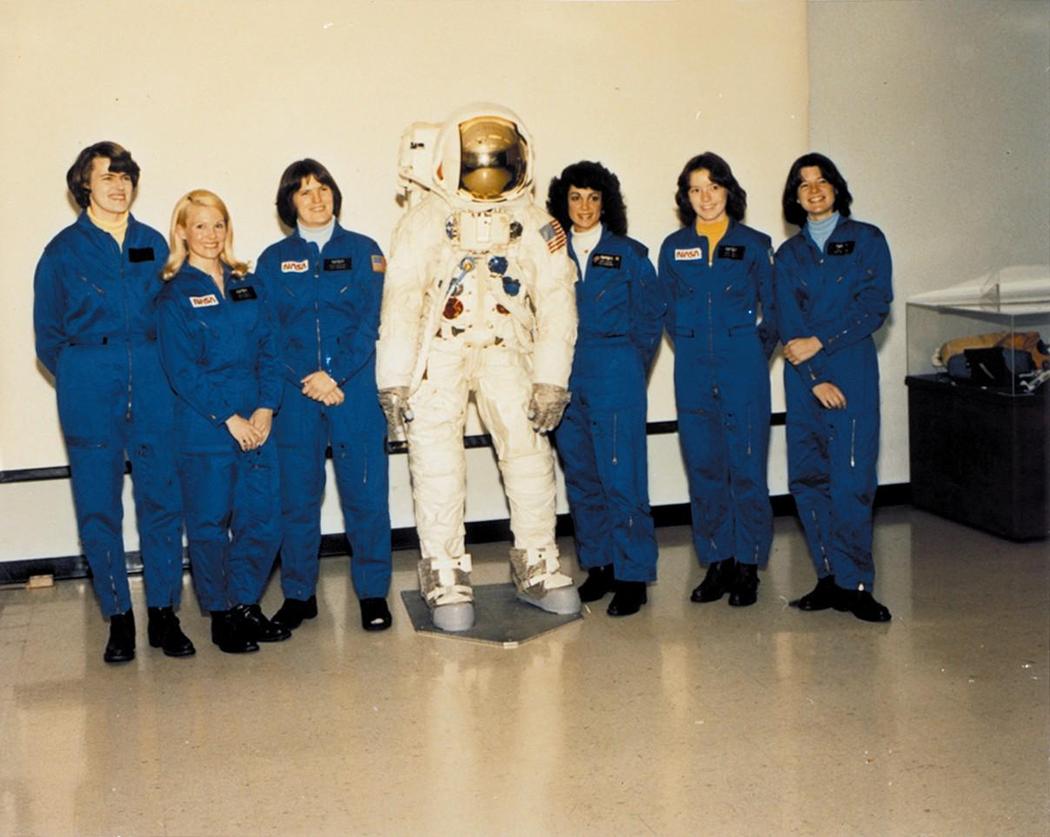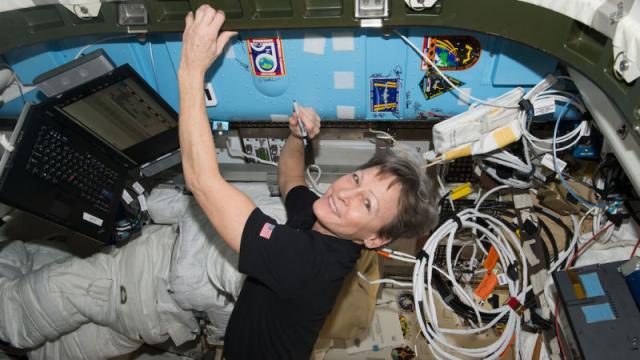In 59 years, NASA has flown more than 50 women into space. That might seem like a reasonable number, but when you consider the space agency has flown hundreds of men over the same time period, it’s a tad unsettling. If we ever want to actually colonise a planet like Mars, we’re going to have bring hundreds of women, or thousands.
Image: Peggy Whitson/NASA Johnson via Flickr
Which is why women at the Human to Mars conference gathered in a sparse auditorium in Washington DC to discuss how critical it is to fly more female astronauts and study how they respond physically and mentally to the challenges of zero gravity.
“We don’t have as big of a database of women [astronauts], so it’s always a little harder to get statistical data, but we do see differences” in how men and women are affected by spaceflight, Ellen Stofan, former chief scientists at NASA, told Gizmodo at the summit. “It’s important not just to have a woman spend an extended time in space, but to have multiple more subjects.”
At this point, we are just starting to learn how long duration spaceflight affects the human body. Numerous studies confirm that people experience inevitable effects of microgravity.
Researchers at the University of Michigan are investigating why astronauts’ brains change shape during spaceflight — they have already found that the volume of grey matter fluctuates during short and long duration missions.

Photo: NASA via AP
One of our richest sources of data so far comes from NASA’s Twin Study, which analysed astronaut Scott Kelly during a year in space, comparing his health to that of his brother, former astronaut Mark Kelly, back on Earth. So far, the Twin Study has taught us that extensive travel impacts the body in unexpected ways.
For example, the protective caps on Scott’s chromosomes, called telomeres, grew while he was in space, returning to pre-flight levels shortly after he returned to Earth. Scientists are still trying to understand what this means, as there’s some concern that telomere lengthening is associated with disease.
Other scientists in NASA’s Human Research Program are analysing fluid and tissue samples collected before, during and after Kelly’s Year in Space, to tease out potential changes in his immune system, gut bacteria, and cardiovascular function.
There’s no Twin Study for women. But from what we do know, we can’t assume what applies to men always applies to women. One study published in the Journal of Women’s Health in 2014 notes that women reach a maximal number of safe days in space earlier than men because they have a “higher incidence of radiation-induced cancers” like lung, thyroid, breast and ovarian.
At a Humans to Mars conference panel on sex and gender in space, researchers reiterated that women’s reproductive organs may be more sensitive to the radiation exposure of spaceflight than men’s.
The little data we have from women astronauts points to other unexpected differences between the sexes — for instance, a mysterious eye condition called visual impairment intracranial pressure syndrome (VIIP) appears to be more prevalent in male astronauts, Stofan told Gizmodo.
Preliminary research suggests that female astronauts may be more susceptible to urinary tract infections while in space and orthostatic intolerance following their return to Earth, compared with their male counterparts.
It’s hard to say just how important these differences are. Some, even some women astronauts, think they aren’t. “We study astronauts as a population, and we certainly have a number of women in that population, and while there may be small differences, there really are not large, driving differences there,” NASA astronaut Kate Rubins told Gizmodo.
Others would contend that those differences are very important, but the reality is, we won’t know for sure until we get more women on crews. Frustratingly, that’s been a challenge from day one.
On June 16, 1963, Soviet cosmonaut Valentina Tereshkova became the first woman in space. Her three-day sojourn was short but profound, orbiting the planet 48 times before finally returning to Earth. Despite numerous trips into orbit and even to the Moon, it took the United States another 20 years to send its first woman into space. Even then, Sally Ride had to navigate through the boys’ club NASA was at the time — in a now-infamous incident, engineers once offered her 100 tampons for a seven-day trip.
Today, the gender ratio remains pretty skewed — Of NASA’s 44 active astronauts, just 14 are women. Of the five astronauts currently aboard the ISS, just one — Peggy Whitson — is a woman. This is despite the fact that more women than ever are applying to become astronauts.
To date, not a single woman astronaut has travelled beyond low Earth orbit.

Image: NASA/NSBRI
While there’s no conspiracy keeping women out, implicit bias poses a real barrier for women pursuing careers in STEM. Research suggests that as early as elementary school, girls are discouraged in their maths and science classes. Even if they’re able to clear hurdles in their early academic careers, women scientists are more likely to be discriminated against by professors and employers. Sound familiar?
“It’s a big frustration of mine, in terms of it being a pipeline problem,” Stofan told the audience at Humans to Mars. “It’s one thing to say, ‘Oh, let’s have programs where we encourage girls and people of colour to go into STEM,’ but then if they go into a STEM environment…we see the numbers decline again. It’s not enough to open the door, you have to make people feel welcome.” The fact that very few women were found on panels at Humans to Mars only served to reinforce her point.
Luckily, the next generation of women in space exploration is keen on going further than their predecessors, both literally and figuratively. Some aspiring astronauts, like Abigail Harrison, have been publicly advocating the need to fly more women. In Harrison’s mind, the psychological effects of space travel on women are as understudied — and important — as the physical effects.

Sally Ride (right) stands among other members of NASA’s first all-women astronaut class. Image: NASA
“One of the ways we could really benefit from having a woman in space long-term — multiple men and multiple women — is looking at mental health,” Harrison told Gizmodo. “We know women and men are socialised differently in society, and that does affect the way they react to things like separation anxiety, being in confined spaces, and ability to work in teams.”
NASA’s Hi-SEAS experiment is taking a first step toward understanding the psychological effects of a trip to Mars, by isolating groups of men and women in a sealed dome on the slopes of a barren Hawaiian volcano to see how they work and live together. So far, the results have been promising.
Ultimately, the way forward is to fly more women astronauts, and study them. Of course, there’s another critically important reason for sending more women into space, beyond expanding our understanding of human biology.
“If we don’t include women in the equation, we’re taking away 50 per cent of the brainpower and the creativity and everything you need in order to continue innovation forward,” Harrison said.
NASA scientist Robert Moses echoed this sentiment more bluntly.
“On a missions to Mars? We’re going to have our Apollo 13,” he told Gizmodo. “Who do you want in the room — room full of middle aged white men? You want women and women. You want as many heads together solving that problem.”
